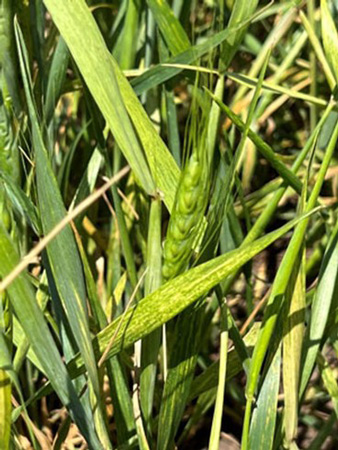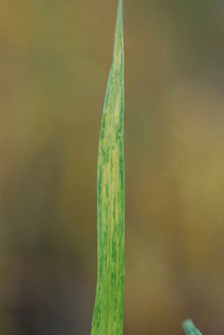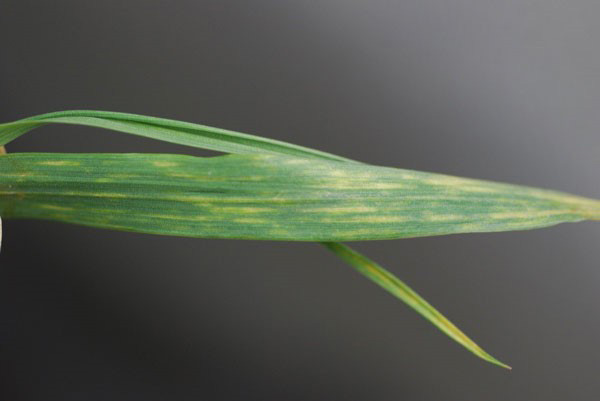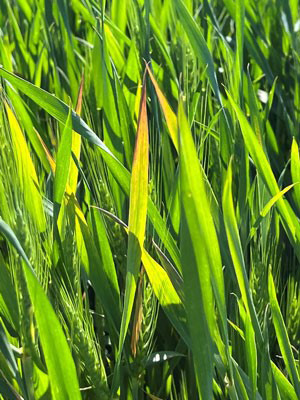It’s the pesky time of year when wheat viruses are rearing their ugly heads in Kansas. Wheat streak mosaic virus and Triticum mosaic virus have been confirmed in several Kansas counties already this spring. The widespread prevalence of wheat streak mosaic complex last season, coupled with warm conditions last fall, suggest that we might be in for another year with high levels of this disease. Now is a good time to scout fields and note any yellowing.
Other than the wheat streak mosaic complex, we have a few other wheat viruses that are active in Kansas. While wheat viruses can sometimes be difficult to distinguish by eye, they do behave differently in the field. Here is a review of some key facts about wheat viruses and some timely reminders for sample submission to the Plant Disease Diagnostic Lab.
Wheat Streak Mosaic Virus Complex
The viruses that cause wheat streak mosaic need no introduction in many parts of Kansas. Wheat streak mosaic is one of the most economically devastating wheat diseases in the state. While this disease is most common in western Kansas, we have seen an uptick in the frequency of occurrence of this disease in central and eastern Kansas over the last couple of years. This disease complex can be caused by several viruses, including wheat streak mosaic virus, triticum mosaic virus, and wheat mosaic virus (high plains). These viruses are moved around by the tiny wheat curl mite, which survives between seasons on volunteer wheat and other grassy hosts. Infections can occur in the fall or spring but can result in more severe yield loss when they occur in the fall after planting. Wheat streak mosaic symptoms develop most rapidly at temperatures above 70?. We often see symptoms appear when temperatures warm in the spring. We expect to see an increase in samples in the diagnostic lab over the coming weeks as the crop moves into and past the jointing stages of growth. Symptoms appear as green and yellow streaks on wheat leaves (Figure 1). The best management strategy is to destroy volunteer wheat immediately after harvest and within two weeks of fall planting. There are some varieties that carry limited resistance to these viruses. More info on how your varieties stack up against this complex of viruses can be found in the Kansas Wheat Variety Guide: https://bookstore.ksre.ksu.edu/pubs/MF3383.pdf

Figure 1. Stunted plants infected with wheat streak mosaic virus exhibiting classic green and yellow mosaic symptoms. Photo: Kelsey Andersen Onofre, K-State Research and Extension.
Wheat Soilborne Mosaic Virus
Wheat soilborne mosaic virus is most common in the eastern two-thirds of Kansas and typically first appears as large, irregular patches of stunted, yellowing wheat in a field. From the road, these can be confused with a number of other production problems such as winter injury, or nutrient deficiencies. Upon closer inspection, leaves appear to have a yellow background with irregular green blotches (Figure 2). Optimal temperatures for symptoms of this virus are cool (around 60 F). The symptoms fade daytime temps rise into the mid-70s. Because of this cool temperature preference, we typically see symptoms at the tillering through jointing growth stages and not later in the season.
This virus is vectored into wheat by a fungal-like organism called Polymyxa graminis that can survive in the soil for up to 30 years. When soil moisture is high, this organism produces spores that can swim and attach themselves to wheat roots. After they attach, they shepherd in the virus, and infection occurs. Infection may be the worst in areas of the field with higher moisture (such as low spots) and in continuous wheat fields. Equipment has the potential to move soil-infested spores to new locations.
Luckily, many of the varieties available in the eastern part of Kansas have resistance to this virus. Susceptible varieties are at risk of yield loss caused by the disease. Much of this yield loss is attributed to lower kernel weight and fewer kernels per spike. To check if your variety is resistant, please see the Kansas Wheat Variety Guide: https://bookstore.ksre.ksu.edu/pubs/mf991.pdf. For more information on this virus: https://bookstore.ksre.ksu.edu/pubs/ep166.pdf.

Figure 2. Wheat with symptoms of wheat soilborne mosaic virus. Photo by Erick DeWolf, K-State Research and Extension.
Wheat Spindle Streak Mosaic Virus
Wheat soilborne mosaic virus can be confused with a second virus known as wheat spindle streak mosaic virus. It is not uncommon to see plants infected with both soil-borne mosaic and spindle streak mosaic. This virus is also most common in eastern Kansas. This virus is also transmitted by Polymyxa graminis and the conditions for infection (cool, wet soil) are similar. This virus will also show up first as yellowing patches in the field. There are subtle symptom differences between these two viruses, with spindle streak symptoms appearing as thin yellow streaks, or dashes on green leaves (Figure 3). Spindle streak can result in reduced tillering which may drive yield reductions. As with soilborne mosaic virus, variety resistance is really the only management tool that we have but can be highly effective. To check if your variety is resistant, please see the Kansas Wheat Variety Guide: https://bookstore.ksre.ksu.edu/pubs/mf991.pdf.

Figure 3. Wheat with symptoms of wheat spindle streak mosaic. Notice the yellow, linear lesions that are tapered at both ends. Photo by Erick DeWolf, K-State Research and Extension.
Barley Yellow Dwarf
Unlike the two viruses mentioned above, barley yellow dwarf virus is transmitted by several species of aphids while they feed, including bird-cherry-oat aphids, English grain aphids, and greenbugs. Infection can occur in the fall or the spring, with fall infections resulting in the highest potential for yield losses. Avoidance of early planting, variety resistance, and systemic insecticide seed treatments are the best way to manage this virus. Symptoms usually appear as purple to yellow leaf tip discoloration and plants will appear stunted (Figure 4). The symptoms of barley yellow dwarf are most visible between jointing and early stages of grain development when warm temperatures favor disease development. Heads of infected plants may be darkened before harvest and grain can be shriveled, resulting in yield losses.

Figure 4. Classic red/purple leaf tips of wheat infected with barley yellow dwarf. In some cases, symptoms will appear more yellow. Photo by Kelsey Andersen Onofre, K-State Research and Extension.
See this recent eUpdate article for information on how to best submit a sample for wheat virus testing to the plant disease diagnostic lab: https://eupdate.agronomy.ksu.edu/article/k-state-plant-disease-diagnostic-laboratory-fee-adjustments-634-7.
Kelsey Andersen Onofre, Extension Plant Pathologist
andersenk@ksu.edu
Tags: wheat disease wheat streak mosaic scouting wheat virus